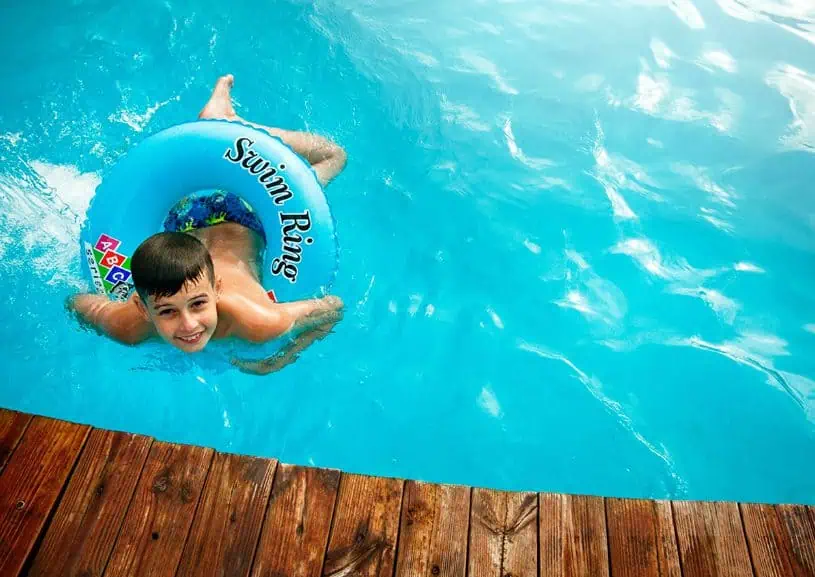Your pool can be an amazing way for your entire family to have fun this summer. However, pools have a lot of hidden dangers that you need to be aware of. There is a right and a wrong way to swim safely. Without the proper precautions, a fun afternoon at the pool can turn into a nightmare. Drowning is a leading cause of death in children, but adults are also susceptible. According to the CDC, there are an average of 11 deaths due to drowning every day in the United States.
Fortunately, there are several things you can do to protect you and your family from the risk of drowning. Follow this guide for the most important safety tips so your whole family can swim safely this summer.
1) Never Swim Alone
The first rule of swimming is to always have a buddy. You are statistically more likely to drown if you’re in a pool by yourself. Children should always be supervised by an adult while in a pool or while near water. Supervising adults should be designated “water watchers,” which means that they should not be distracted while supervising others who are swimming. Do not text, read, or play games while watching swimmers. Water watchers should also have a phone nearby to call for help in case of a drowning emergency.
Even if you are at a public pool with lifeguards, an adult should supervise children while swimming. Lifeguards cannot see everything. If one lifeguard takes a break or is distracted, other lifeguards may not be able to see the entire pool area.
2) Secure Your Pool
Many drowning accidents with children happen when children were not expected to be near a pool in the first place. If your pool is not properly secured when not in use, children or pets may be more likely to wander too close and fall in. By the time an adult notices they may be missing, it is often too late. Securing your pool properly when not in use is the key to making sure this doesn’t happen.
Make sure your inground pool is surrounded on all four sides by a fence or other barrier that is self-latching and out of reach of children. Four-sided isolation fences that separate the pool from the yard reduce a child’s risk of drowning 83% compared to three-sided property-line fencing.
Above-ground pools should have lockable covers or have the steps or ladders locked or removed so a child cannot climb in when they aren’t supervised.
You can also install door and gate alarms that will alert you when someone crosses into the pool area. There are even alarms that you can place in the pool that will sound when motion is detected in the water.
3) Teach Proper Pool Etiquette
All adults and children in the family should be taught proper pool etiquette, starting with swimming lessons. Every member of the family should be able to enter the water safely, stay afloat, change position, swim for a distance, and then get out of the water safely. If you have small children or family who are not strong swimmers, they should wear lifejackets while near the water to keep them safe from drowning. There are many free and reduced-cost options for swimming lessons from local YMCA branches or Park and Recreation Departments, so check around and enroll your family ASAP.
Learning to swim, however, is only half of pool etiquette. You should never run near a pool; you could slip and fall in or injure yourself. Stay away from pool drains to avoid parts of your bathing suit, hair, or jewelry being sucked into the drain. Adults should always swim sober; do not ingest alcohol before or during swimming. Don’t bring glass bottles into the pool area either. They could break and cause a hazard. Make sure everyone swimming knows the pool rules, and as a pool-owner you should be prepared to remove any guests that may not be following the rules to keep everyone else safe.
4) Keep Up with Maintenance
As a pool owner, it is your responsibility to make sure to keep up with regular pool maintenance. Letting any kind of maintenance slide could create a problem or pose danger to swimmers. Make sure that all your drain covers are working properly to avoid clothing or hair from being sucked into a drain. You should also ensure that any adult supervising your pool knows where the safety release system is in the case of a drain emergency.
You should stay on top of the chemical maintenance of your pool, as well. When used properly, chlorine kills bacteria and parasites in the water to keep you healthy. However, if the chemicals used to clean your pool are mishandled or misused, you could be at a risk for waterborne illness. And never leave chemicals unattended; keep your pool chemicals in a locked cabinet out of reach of children where they cannot be accidentally ingested.
5) Create Layers of Protection
Adhering to all the above tips simultaneously creates what is called “layers of protection” in water safety. Just one prevention strategy often isn’t enough but combining them all together is what is the most effective in preventing drowning or other water-related injury. Preventing access to the pool when not in use, supervising, keeping up with maintenance, following pool rules and making sure all swimmers know the basics of swimming are a multi-layered strategy that works to keep people safe.
Have Fun and Stay Safe
Having a pool in your backyard is a big responsibility, but when safety procedures are followed properly, swimming can be fun for the whole family. Pools can be daunting to maintain by yourself, so if you’re ever in doubt or have any questions, you can call your friendly, local experts at Cincinnati Pool and Patio for help with water maintenance, safety equipment, and pool openings and closings. We can even inspect your pool to make sure everything is working properly; there could be something you’re missing that an expert would catch!
With all this in mind, have fun, be safe, and happy swimming!

